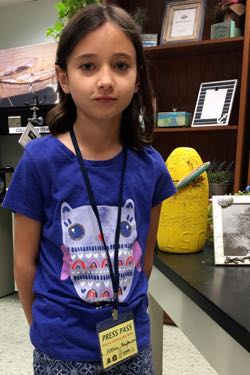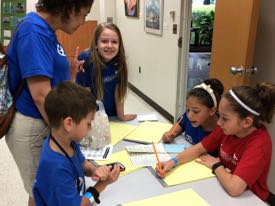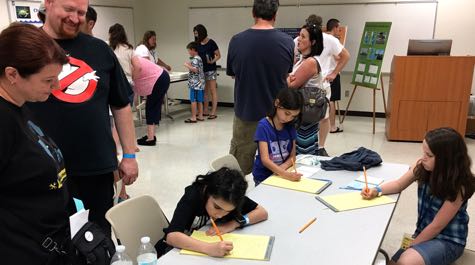Young reporters uncover secrets of Marine Science Day
This year, staff at the Virginia Institute of Marine Science gave young visitors to Marine Science Day an opportunity to report on their experiences. The stories filed by these intrepid journalists wonderfully describe all the fun and learning that takes place during the Institute's annual open house, and reveal the reasons for the event's continuing popularity.
Dr. John Wells, VIMS Dean & Director, says "the reporters worked very hard by interviewing scientists and observing sea creatures throughout the day. They asked probing questions, and wrote some hard-hitting pieces of investigative journalism. We are proud to publish their work in our inaugural issue of the Marine Science Day News."
David Malmquist, Director of News & Media Services at VIMS, says he was particularly pleased that all members of the reporting staff were able to file their stories by their assigned deadlines.
 From the world of fisheries science, reporter Fresia Kaplan-Meynard was able to uncover how big kids are when compared to a sturgeon. She also discovered that when you have lots of baby striped bass they eat each other, so you have to feed them a lot. Staff writer Layla Rose gave a behind-the-scenes look at seining in the York River, and the many sea creatures that live there. Reporting on eels and other ocean animals was first-time fishing columnist others look like rocks."
From the world of fisheries science, reporter Fresia Kaplan-Meynard was able to uncover how big kids are when compared to a sturgeon. She also discovered that when you have lots of baby striped bass they eat each other, so you have to feed them a lot. Staff writer Layla Rose gave a behind-the-scenes look at seining in the York River, and the many sea creatures that live there. Reporting on eels and other ocean animals was first-time fishing columnist others look like rocks."
Crabs also proved a popular story topic. Reporter Christian Lewis discovered that "crabs have poise," and that "All crabs aren’t mean and 'crabby.'" Reporter Camille Phillips revealed the secrets behind crab molting, while colleague Chloe Phillips was surprised to learn that "the crab couldn’t bite me because… CRABS Don’t Have Teeth!" Reporter Amiyah Taylor explained the time-tested method for telling the difference between male and female blue crabs. The reporting team of
Heather Warbington, reporting from the world of shellfish, took on the age-old questions that swirl around oysters and pearls. "The world is your oyster, and you are the pearl,” she writes. "People say it all the time, but do they truly know what an oyster is? Do they know why we use that quote?" Read her story to find the answer!
 Three reporters decided to work on human-interest stories featuring selected VIMS scientists.
Three reporters decided to work on human-interest stories featuring selected VIMS scientists.


